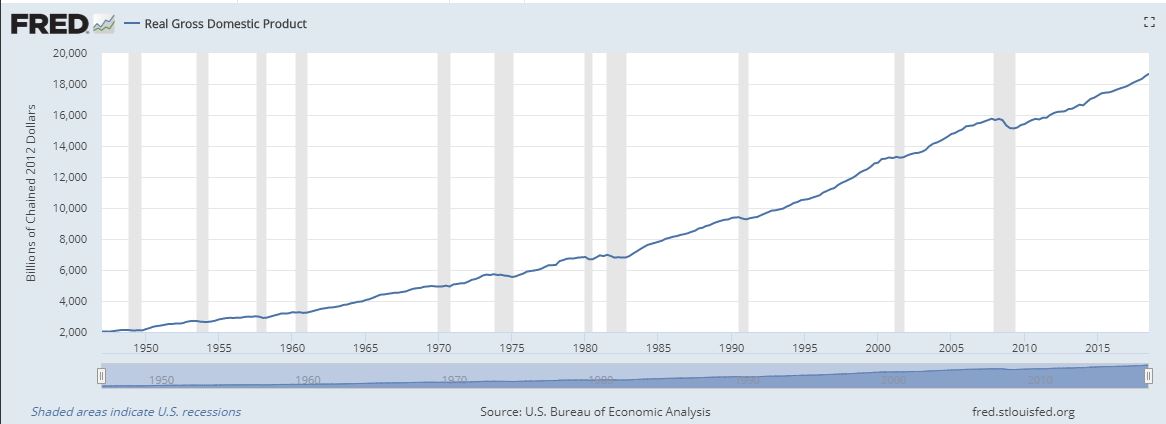In a recent Twitter thread started by the venerable Jim O’Shaughnessy (@jposhaughnessy), I said:
If everyone were a rational long term investor, the market return would be precisely equal to GDP growth. I personally am grateful to those that build castles in the air. My biggest fear is the AIs will all converge on the same algos, & start doing identical logical stuff.
As several of Mr.O’Shaughnessy’s followers pointed out, I was incorrect in my relating Gross Domestic Product (GDP) to equity returns. In truth, GDP and equity returns are derived from different elements. The common thread is that equity returns are a function of GDP because the profit growth of companies is a massive factor in computing GDP.
GDP returns can be attributed to four elements, as the Atlanta Fed explains:
One way that we calculate GDP is by looking at sources of expenditure—you know, what are people buying? This gives us a standard GDP identity of consumption plus investment plus government spending plus net exports. Consumption is fairly straightforward—it’s the largest component in the U.S. It’s about 70 percent of our overall economy. That’s just the stuff we buy, goods and services. We are becoming a more and more service-oriented economy, but that’s not because we are buying less goods. It’s just because our income level now on a per capita basis is high enough that a lot of us already have all the toasters that we want…. Now we are buying medical care or dentistry or meals outside the home or some services that we couldn’t afford before. And so a transition towards a more service-based economy is not really a bad thing, particularly for high-income countries. It’s just a sign of growing income.
Earnings growth depends on the nominal GDP since the earnings form a part of the GDP. According to Professor Robert Shiller, earnings per share on the S&P 500 grew at a 3.8% annualized rate between 1874 and 2004. If we adjust those numbers to take into account inflation, we have a real growth rate of 1.7%. The annual S&P 500 dividend yield averaged just 1.99% between 2009 and 2015.
Stock returns can be attributed to a mere three elements:
- The first is the growth in earnings of your particular segment of the market’s overall earnings over a given time frame.
- The second are all dividends paid out to you over that time frame.
- The third is the change in valuation (P/E ratio) applied to the asset between the start and end date.
For a single stock, earnings growth can be significantly different than the mean in any given period. If we choose an index such as the S&P 500 as a proxy for the “market,” we will find a modest yet persistent positive tilt to the upside. In theory, one would expect market earnings growth to be a flowthrough of GDP growth. If the economy is doing very well and growing at an impressive clip, then American corporations will prosper and “high tides lifts all ships.”
AIs and the Future of Investing
Many investors see algorithm as a four-letter word, and call an algorithm an “algo.” The reason for this hatred is that algos move massive amounts of stock at unfathomable speeds. It is reasonable to assume that volatility is increased when the most common “triggers” in the data feed are hit. For this to work, other traders have to be present to take the opposite side of the trade. The current state of the art is for humans to stick in the variables and set the cut points for executing trades.
Imagine that Moore’s law stays in play and that computing power keeps doubling every 18 months or so. There will come a time in the not too distant further when self-teaching AIs will begin to devise and test all possible models using all possible data and determine the most accurate regression equations possible. For a while, the firms that build the best AIs will have a distinct advantage and make staggering amounts of money. As AI technology becomes ubiquitous and prices begin to drop (as is part of the lifecycle of all technologies), more and more people will have access to the absolute best possible models.
After massive volatility storms rock the market for a period when these advanced, hierarchical models first appear, things will start to settle down in a dramatic way. If every investor has a portfolio based on the model with the absolute highest R-square possible, then everyone will essentially want to make the same trades at the same time. Under current market conditions, alpha is largely achieved through arbitraging irrational behavior by human actors. If the “animal spirits” are banished to the netherworld, trading will become a very boring pastime indeed. Irrational panics will be a thing of the past, as will be “irrational exuberance.” My predictions are that:
- Volatility will drop to all-time lows, and will only spike when new economic fundamental data is made available and when there is a fat-tail geopolitical event (e.g., 9/11).
- P/E ratios will shrink to historical lows and trend sideways
- Productivity will increase manyfold, so GDP and wages will go up at a much-accelerated rate
Given such a market and applying my assertions, the market return will boil down to
earnings growth + dividends
If we plug in the historical averages mentioned above, we get something like 2.0% + 1.7% = 3.7% growth per anum in the value of equities. That figure puts us in the same ballpark as overall GDP growth. It also puts equity returns in the same ballpark as bond returns. In the not so distant future, the quest for alpha will be relegated to myth and legend, much like the quest for the Holy Grail.
